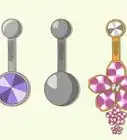This article was co-authored by Roger Rodriguez and by wikiHow staff writer, Amber Crain. Roger Rodriguez, also known as Roger Rabb!t, is the Owner of Ancient Adornments Body Piercing, a piercing studio based in the Los Angeles, California area. With over 25 years of piercing experience, Roger has become the co-owner of several piercing studios such as ENVY Body Piercing and Rebel Rebel Ear Piercing and teaches the craft of body piercing at Ancient Adornments. He is a member of the Association of Professional Piercers (APP).
There are 12 references cited in this article, which can be found at the bottom of the page.
wikiHow marks an article as reader-approved once it receives enough positive feedback. This article has 11 testimonials from our readers, earning it our reader-approved status.
This article has been viewed 770,651 times.
Your newly pierced ears look absolutely fabulous! To make sure they stay that way, it's important to clean the piercings properly—but what's the process? We've got you! In this article, we'll explain how to clean your piercings during the healing phase, deal with an infection if you happen to get one, and share our best tips for keeping piercings healthy once they're all healed up. Keep on scrolling to learn everything you need to know about ear piercing care!
Things You Should Know
- Wash your hands thoroughly before handling your piercing.
- Clean the piercing twice a day with saline solution and rotate the posts a few times while the area is still wet.
- If you get an infection, remove the earring and wipe the post down with alcohol. Coat the post with antibacterial ointment before reinserting the earring.
- If infection symptoms like fever, pain, or discharge last more than 5-7 days, see your doctor to get a prescription for oral antibiotics.
Steps
Cleaning New Piercings
-
1Wash your hands thoroughly with antibacterial soap. Before handling your new piercing, scrub your hands with warm water and soap to remove germs and dirt. If you transfer germs to your piercing, you could get an infection.[1]
- When you're away from home, carry a bottle of hand sanitizer in your bag. That way, if you can't wash your hands, you can at least sterilize your fingers before touching your piercing.
- Try to avoid touching your piercings between cleanings.[2]
-
2Dip a cotton ball or swab in saline cleaning solution. Many piercing professionals will provide you with an ear piercing cleaning solution after you get your piercing (which is typically a saline solution). If you need to make your own saline solution at home, mix 1/4 teaspoon (3 g) of sea salt or table salt into a 1 cup (237 ml) of warm water.[3]
- Avoid using rubbing alcohol or hydrogen peroxide to clean your new piercing since they can slow down the healing process.
Advertisement -
3Swab around the pierced area with the cotton ball or swab. Gently sweep the solution over both sides of each ear at the site of the piercing so it's saturated with saline solution. The saline cleans the area and softens any loose or crusted skin around the piercing.[4]
- If you don't have saline, wash the pierced area with mild, fragrance-free soap and warm water instead.[5]
- You don't need to use antibiotic ointment on a new piercing unless it's irritated or infected. For daily cleaning, saline solution is all you need.
- Remember not to pick at any crusted skin since that could cause an infection. Soften it with the saline solution and gently wipe it away.[6]
-
4Rotate the earring posts a few times while the area is still wet. Gently grasp the post between your fingers and turn it clockwise, then counterclockwise. Rotating the posts helps to keep the skin from getting attached or stuck to your piercing.[7]
-
5Clean your piercing with the saline solution twice a day. Making it part of your morning and bedtime routine is a good way to get into the habit of daily cleaning. It just takes a few minutes and can save you from getting a painful infection.[8]
- To speed up healing time, apply a thin coat of petroleum jelly around the opening of each piercing. Petroleum jelly keeps the piercings moist (and moist wounds heal faster).[9]
-
6Keep your earrings in your ears until they heal. Removing new earrings too soon can cause the earring holes to close up. Most ear piercings are fully healed after 6-8 weeks; after that, it's fine to take the jewelry out whenever you'd like.[10]
- Just don't leave them out too long! Even if the piercings are healed, they can still close up if your body heals super fast.
- Some ear piercings can take longer to heal. For instance, a cartilage piercing could take 4 months to a year to fully heal.
- Avoid swimming until your piercings are fully healed.
Caring for an Infected Piercing
-
1Remove the earrings and clean your skin with saline solution. Before treating your infected piercing, wash your hands with antibacterial soap. Then, saturate a cotton ball with the saline solution and gently wipe down both sides of your pierced skin to disinfect the area and soften any crusted skin.[11]
- Symptoms of an infected piercing include discharge coming out of the piercing, fever, redness, warmth or swelling around the piercing, and pain.
- Handling an infected piercing with dirty hands could cause more complications, so be sure to scrub up![12]
-
2Wipe the earring posts with rubbing alcohol 3 times a day. Germs and bacteria collect on the earrings posts, which fuels the infection. To kill the germs, remove your earrings and wipe the posts thoroughly with rubbing alcohol. Do this 3 times a day until your infection clears.[13]
-
3Cover the posts with antibiotic ointment before reinserting them. Use a new cotton swab to apply ointment to the post of the earrings. You only need a small amount of OTC antibacterial ointment for this. Be sure to do this each time you sterilize the posts with alcohol.[14]
- Applying alcohol and ointment before reinserting the earrings ensures the medication gets inside your earring holes.
- Gently rotate the earrings a few times once you've put them back in.
-
4Apply a warm compress to ease the pain and swelling. To make a warm compress, soak a clean washcloth in warm water. Gently press the cloth over the piercing for 3-4 minutes. You can do this several times throughout the day if you need to.[15]
- Taking NSAIDs like ibuprofen (Advil, Motrin) and naproxen (Aleve) also help with pain relief and swelling. Be sure to read and follow all instructions on the medicine label.[16]
-
5See a doctor if your symptoms last longer than 5-7 days. Most infections can be resolved at home with cleaning and OTC ointment. If the infection doesn't clear up after a week, check with your doctor. You may need to get a prescription for oral antibiotics to knock out the infection.[17]
Maintaining Healthy Ear Piercings
-
1Take your earrings out every night once they've healed. Taking earrings out while you sleep will prevent your earrings from snagging during your sleep. It also allows air to circulate around the skin, which helps to keep your pierced ears healthy.[18]
-
2Clean your earrings with rubbing alcohol when you remove them. Dip a cotton swab in alcohol. Rub it over the posts when your earrings are out for the night. Doing this regularly will help keep the earring free of germs that can cause infection.[19]
-
3Clean your lobes with alcohol or saline solution regularly. Treating healed ear piercings on a weekly or monthly basis reduces the chances of future infections. If your piercings ever begin to feel tender, disinfect the posts with alcohol and apply OTC antibacterial ointment before reinserting them.[20]
Expert Q&A
Did you know you can get premium answers for this article?
Unlock premium answers by supporting wikiHow
-
QuestionHow can I encourage my piercing to heal?
 Roger RodriguezRoger Rodriguez, also known as Roger Rabb!t, is the Owner of Ancient Adornments Body Piercing, a piercing studio based in the Los Angeles, California area. With over 25 years of piercing experience, Roger has become the co-owner of several piercing studios such as ENVY Body Piercing and Rebel Rebel Ear Piercing and teaches the craft of body piercing at Ancient Adornments. He is a member of the Association of Professional Piercers (APP).
Roger RodriguezRoger Rodriguez, also known as Roger Rabb!t, is the Owner of Ancient Adornments Body Piercing, a piercing studio based in the Los Angeles, California area. With over 25 years of piercing experience, Roger has become the co-owner of several piercing studios such as ENVY Body Piercing and Rebel Rebel Ear Piercing and teaches the craft of body piercing at Ancient Adornments. He is a member of the Association of Professional Piercers (APP).
Piercing Specialist
-
QuestionHow long does it take for a new ear piercing to heal?
 Roger RodriguezRoger Rodriguez, also known as Roger Rabb!t, is the Owner of Ancient Adornments Body Piercing, a piercing studio based in the Los Angeles, California area. With over 25 years of piercing experience, Roger has become the co-owner of several piercing studios such as ENVY Body Piercing and Rebel Rebel Ear Piercing and teaches the craft of body piercing at Ancient Adornments. He is a member of the Association of Professional Piercers (APP).
Roger RodriguezRoger Rodriguez, also known as Roger Rabb!t, is the Owner of Ancient Adornments Body Piercing, a piercing studio based in the Los Angeles, California area. With over 25 years of piercing experience, Roger has become the co-owner of several piercing studios such as ENVY Body Piercing and Rebel Rebel Ear Piercing and teaches the craft of body piercing at Ancient Adornments. He is a member of the Association of Professional Piercers (APP).
Piercing Specialist Ear piercings heal very quickly. On average, it takes about six to eight weeks for an ear lobe piercing to heal. Piercings on the cartilage, including your upper ear and your nose, can take anywhere from three to six months. For these piercings, it depends on the amount of work that you're doing to keep them clean and how many piercings you're getting.
Ear piercings heal very quickly. On average, it takes about six to eight weeks for an ear lobe piercing to heal. Piercings on the cartilage, including your upper ear and your nose, can take anywhere from three to six months. For these piercings, it depends on the amount of work that you're doing to keep them clean and how many piercings you're getting. -
QuestionDo I have to clean my ears/earrings after it’s been a year?
 wikiHow Staff EditorThis answer was written by one of our trained team of researchers who validated it for accuracy and comprehensiveness.
wikiHow Staff EditorThis answer was written by one of our trained team of researchers who validated it for accuracy and comprehensiveness.
Staff Answer wikiHow Staff EditorStaff AnswerTo keep your piercing healthy, it's best to clean the skin around the piercing and the earring posts monthly. Take out the earrings, wipe down the pierced area with a cotton ball soaked in saline solution. Then, wipe down the posts of your earrings with alcohol to disinfect them and pop them back into your ears. You're good to go!
wikiHow Staff EditorStaff AnswerTo keep your piercing healthy, it's best to clean the skin around the piercing and the earring posts monthly. Take out the earrings, wipe down the pierced area with a cotton ball soaked in saline solution. Then, wipe down the posts of your earrings with alcohol to disinfect them and pop them back into your ears. You're good to go!
Warnings
- Don't take the earrings out too early, or the holes may close up.⧼thumbs_response⧽
- Talk to your doctor before using antibiotic ointments. Using them too frequently can lead to an allergy.[22]⧼thumbs_response⧽
References
- ↑ https://www.aad.org/dermatology-a-to-z/health-and-beauty/general-skin-care/caring-for-pierced-ears
- ↑ https://pediaclinic.net/Ear-Pierced-Healed-Minor-Infection
- ↑ https://uhs.berkeley.edu/health-topics/body-piercings
- ↑ https://www.nhs.uk/conditions/body-piercing/
- ↑ https://www.aad.org/public/everyday-care/skin-care-basics/tattoos/caring-for-pierced-ears
- ↑ https://www.nhs.uk/conditions/infected-piercings/
- ↑ https://uhs.berkeley.edu/health-topics/body-piercings
- ↑ https://uhs.berkeley.edu/health-topics/body-piercings
- ↑ https://www.aad.org/public/everyday-care/skin-care-basics/tattoos/caring-for-pierced-ears
- ↑ https://www.mayoclinic.org/healthy-lifestyle/adult-health/in-depth/piercings/art-20047317
- ↑ https://my.clevelandclinic.org/health/diseases/21503-infected-ear-piercing
- ↑ https://pediaclinic.net/Ear-Pierced-Healed-Minor-Infection
- ↑ https://pediaclinic.net/Ear-Pierced-Healed-Minor-Infection
- ↑ https://pediaclinic.net/Ear-Pierced-Healed-Minor-Infection
- ↑ https://my.clevelandclinic.org/health/diseases/21503-infected-ear-piercing
- ↑ https://myhealth.alberta.ca/Health/aftercareinformation/pages/conditions.aspx?hwid=abk1292#abs7664
- ↑ https://myhealth.alberta.ca/Health/aftercareinformation/pages/conditions.aspx?hwid=abk1292#abs7664
- ↑ https://my.clevelandclinic.org/health/diseases/21503-infected-ear-piercing#prevention
- ↑ https://www.hopkinsallchildrens.org/Patients-Families/Health-Library/HealthDocNew/Pierced-Ears
- ↑ https://www.hopkinsallchildrens.org/Patients-Families/Health-Library/HealthDocNew/Pierced-Ears
- ↑ https://health.clevelandclinic.org/what-to-expect-when-getting-your-ears-pierced/
- ↑ https://health.clevelandclinic.org/what-to-expect-when-getting-your-ears-pierced/
About This Article
To clean a new ear piercing, start by washing your hands thoroughly with soap and water. This will prevent you from accidentally introducing dirt or germs into the piercing. Next, dip a cotton swab into a gentle saline cleaning solution. Most piercing experts don’t recommend using harsh disinfectants, like alcohol or hydrogen peroxide, since they can irritate the piercing and slow down healing. Gently clean the area around the piercing on the front of your ear with the cotton swab. Soak a new swab in the solution and clean the back of your ear as well. While you’re at it, gently turn the jewelry in the piercing about half a turn to keep it from sticking to your healing skin. Finish up by dabbing a small amount of antibiotic ointment on the front and back of the piercing with a fresh cotton swab. Give the jewelry half a turn to help work the ointment into the hole. Aim to clean your piercing at least once or twice a day, and don’t switch out your jewelry until the piercing is completely healed. In your earlobe, this should take about 6 weeks. If it’s in the cartilage, it may take a few months. Once the piercing is healed, take the jewelry out every night before you go to bed. Clean the jewelry with rubbing alcohol before putting it back in. Continue to wash your piercing with saline solution and treat it with antibiotic ointment at least once a month to prevent infections and keep the area healthy. If you see signs of an infection, such as redness, pain, bleeding, or discharge from the piercing, call your doctor for advice. To learn how to maintain healthy ear piercings, scroll down!

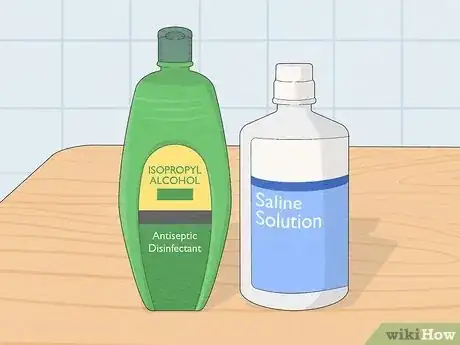
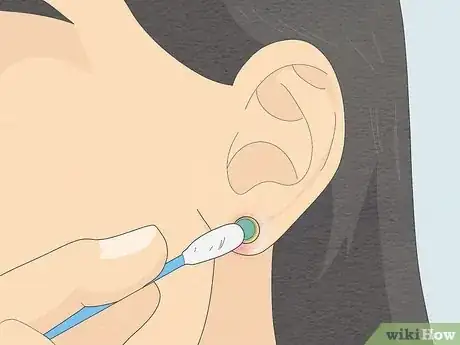
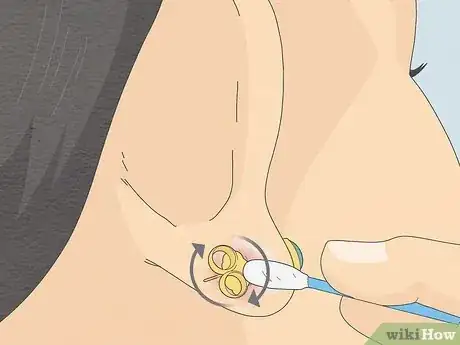
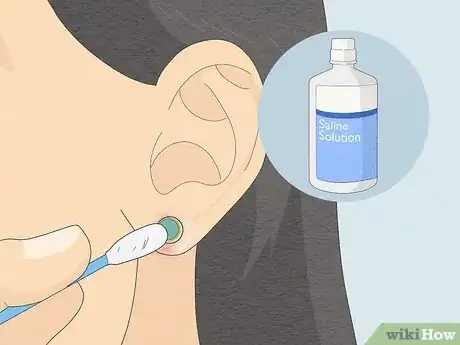
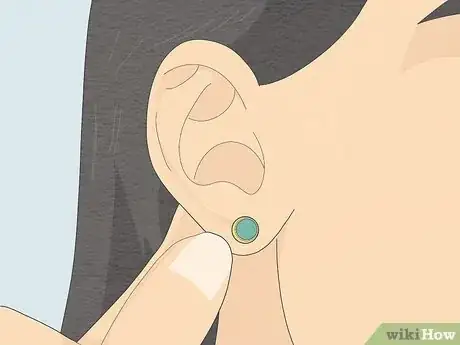
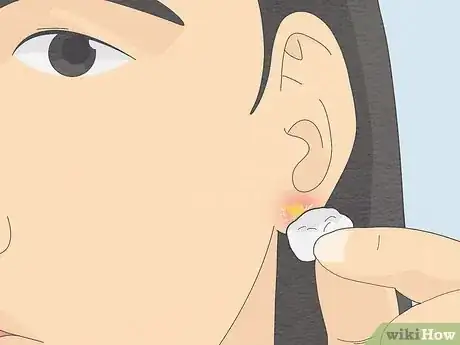
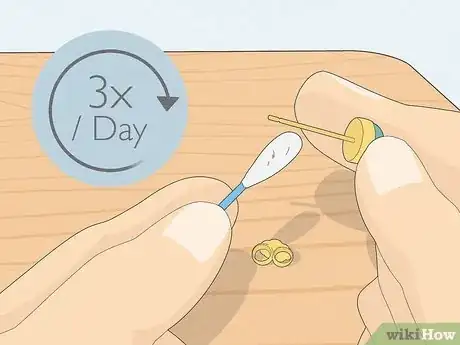

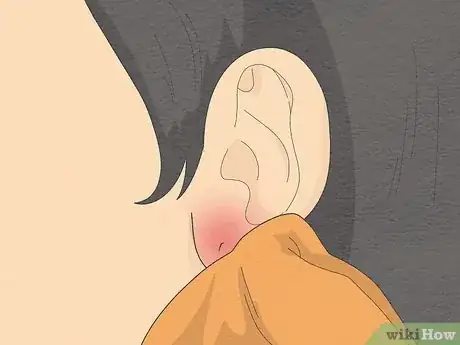


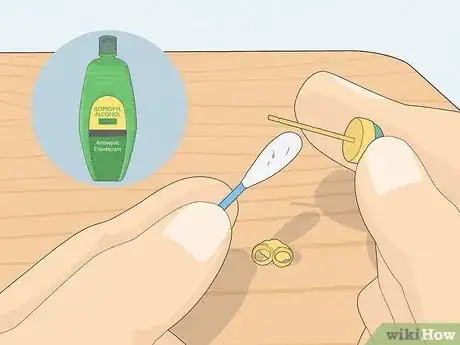
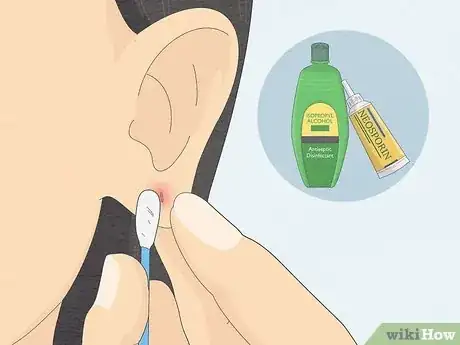

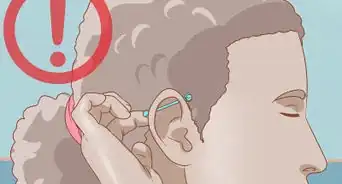
-Piercing-Step-19.webp)



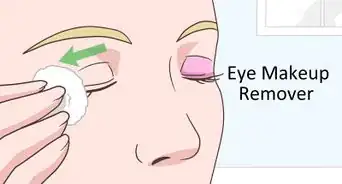

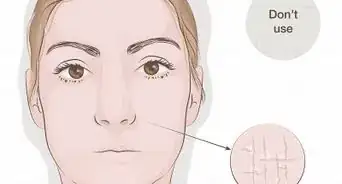


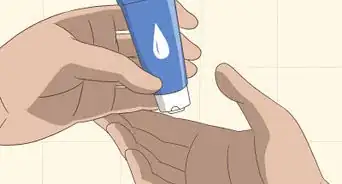













-Piercing-Step-19.webp)
